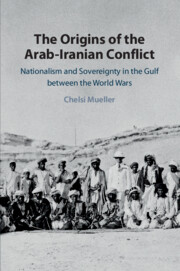 The Origins of the Arab-Iranian Conflict
The Origins of the Arab-Iranian Conflict Published online by Cambridge University Press: 24 July 2020
This chapter highlights the primary features of politics and society in the Persian Gulf from the rise of civilization to World War I. It provides a survey of state-tribe relations in the Gulf from antiquity until the introduction of European powers. It will then turns to a consideration of the triangular relationship between states, tribes, and foreign powers in the Gulf, with an emphasis on the period of British supremacy. It identifies the appropriate theoretical tools pertaining to tribes and tribal politics in the Arabian Peninsula, which can be used to better understand how British intervention was viewed by the tribally organized societies situated around the Gulf's perimeter. The advent of nationalism in Iran and the consolidation of Iran's frontiers beginning in the late Qajar period are discussed as well as the waves of Iranian immigration that laid the foundations of politics and society in the Gulf Arab shaykhdoms. The chapter concludes with an analysis of the profound changes that were beginning to take shape in the regional system on the eve of World War I.
To save this book to your Kindle, first ensure [email protected] is added to your Approved Personal Document E-mail List under your Personal Document Settings on the Manage Your Content and Devices page of your Amazon account. Then enter the ‘name’ part of your Kindle email address below. Find out more about saving to your Kindle.
Note you can select to save to either the @free.kindle.com or @kindle.com variations. ‘@free.kindle.com’ emails are free but can only be saved to your device when it is connected to wi-fi. ‘@kindle.com’ emails can be delivered even when you are not connected to wi-fi, but note that service fees apply.
Find out more about the Kindle Personal Document Service.
To save content items to your account, please confirm that you agree to abide by our usage policies. If this is the first time you use this feature, you will be asked to authorise Cambridge Core to connect with your account. Find out more about saving content to Dropbox.
To save content items to your account, please confirm that you agree to abide by our usage policies. If this is the first time you use this feature, you will be asked to authorise Cambridge Core to connect with your account. Find out more about saving content to Google Drive.